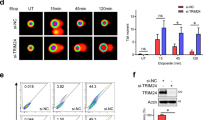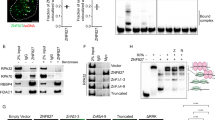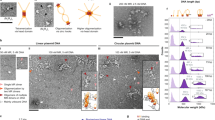Abstract
The recognition and repair of DNA double-strand breaks (DSBs) is a complex process that draws upon a multitude of proteins. This is not surprising since this is a lethal lesion if left unrepaired and also contributes to genome instability and the consequential risk of cancer and other pathologies. Some of the key proteins that recognize these breaks in DNA are mutated in distinct genetic disorders that predispose to agent sensitivity, genome instability, cancer predisposition and/or neurodegeneration. These include members of the Mre11 complex (Mre11/Rad50/Nbs1) and ataxia-telangiectasia (A-T) mutated (ATM), mutated in the human genetic disorder A-T. The mre11 (MRN) complex appears to be the major sensor of the breaks and subsequently recruits ATM where it is activated to phosphorylate in turn members of that complex and a variety of other proteins involved in cell-cycle control and DNA repair. The MRN complex is also upstream of ATM and ATR (A-T-mutated and rad3-related) protein in responding to agents that block DNA replication. To date, more than 30 ATM-dependent substrates have been identified in multiple pathways that maintain genome stability and reduce the risk of disease. We focus here on the relationship between ATM and the MRN complex in recognizing and responding to DNA DSBs.
This is a preview of subscription content, access via your institution
Access options
Subscribe to this journal
Receive 50 print issues and online access
$259.00 per year
only $5.18 per issue
Buy this article
- Purchase on Springer Link
- Instant access to full article PDF
Prices may be subject to local taxes which are calculated during checkout


Similar content being viewed by others
References
Adams KE, Medhurst AL, Dart DA, Lakin ND . (2006). Recruitment of ATR to sites of ionizing radiation-induced DNA damage requires ATM and components of the MRN protein complex. Oncogene 25: 3894–3904.
Agarwal S, Tafel AA, Kanaar R . (2006). DNA double-strand break and chromosome translocations. DNA Repair 5: 1075–1081.
Ali A, Zhang J, Bao S, Liu I, Otterness D, Dean NM et al. (2004). Requirement of protein phosphatase 5 in DNA-damage-induced ATM activation. Genes Dev 18: 249–254.
Bakkenist CJ, Kastan MB . (2003). DNA damage activates ATM through intermolecular autophosphorylation and dimer dissociation. Nature 421: 499–506.
Bekker-Jensen S, Lukas C, Kitagawa R, Melander F, Kastan MB, Bartek J et al. (2006). Spatial organisation of the mammalian genome surveillance machinery in response to DNA strand breaks. J Cell Biol 173: 195–206.
Berkovich E, Monnat Jr RJ, Kastan MB . (2007). Roles of ATM and Nbs1 in chromatin structure modulation and DNA double-strand break repair. Nat Cell Biol 9: 683–690.
Carson CT, Schwartz RA, Stracker TH, Lilley CE, Lee DV, Weitzman MD . (2003). The Mre11 complex is required for ATM activation and the G2/M checkpoint. EMBO J 22: 6610–6620.
Cerosaletti K, Concannon P . (2004). Independent roles for nibrin and Mre11-Rad50 in the activation and function of Atm. J Biol Chem 279: 38813–38819.
Cerosaletti K, Wright J, Concannon P . (2006). Active role for nibrin in the kinetics of Atm activation. Mol Cell Biol 26: 1691–1699.
Costanzo V, Paull T, Gottesman M, Gautier J . (2004). Mre11 assembles linear DNA fragments into DNA damage signalling complexes. PLoS Biol 2: E110.
Costanzo V, Robertson K, Bibikova M, Kim E, Grieco D, Gottesman M et al. (2001). Mre11 protein complex prevents double-strand break accumulation during chromosomal DNA replication. Mol Cell 8: 137–147.
Costanzo V, Robertson K, Ying CY, Kim E, Avvedimento E, Gottesman M et al. (2000). Reconstitution of an ATM-dependent checkpoint that inhibits chromosomal DNA replication following DNA damage. Mol Cell 6: 649–659.
D’Amours D, Jackson SP . (2002). The Mre11 complex: at the crossroads of DNA repair and checkpoint signalling. Mol Cell Biol 3: 317–327.
De Jager M, van Noort J, van Gent DC, Dekker C, Kanaar R, Wyman C . (2001). Human Rad50/Mre11 is a flexible complex that can tether DNA ends. Mol Cell 8: 1129–1135.
Difilippantonio S, Celeste A, Fernandez-Capetillo O, Chen HT, Reina San Martin B, Van Laethem F et al. (2005). Role of Nbs1 in the activation of the Atm kinase revealed in humanized mouse models. Nat Cell Biol 7: 675–685.
Difilippantonio S, Celeste A, Kruhlak MJ, Lee Y, Difilippantonio MJ, Feigenbaum L et al. (2007). Distinct domains in Nbs1 regulate irradiation-induced checkpoints and apoptosis. J Exp Med 204: 1003–1011.
Digweed M, Reis A, Sperling K . (1999). Nijmegen breakage syndrome: consequences of defective DNA double strand break repair. BioEssays 21: 649–656.
Dong Z, Zhong Q, Chen PL . (1999). The Nijmegen breakage syndrome protein is essential for Mre11 phosphorylation upon DNA damage. J Biol Chem 274: 19513–19516.
Dudley DD, Chaudhuri J, Bassing CH, Atl FW . (2005). Mechanism and control of V(D)J recombination versus class switch recombination: similarities and differences. Adv Immunol 86: 43–112.
Dupre A, Boyer-Chatenet L, Gautier J . (2006). Two-step activation of ATM by DNA and the Mre11-Rad50-Nbs1 complex. Nat Struct Mol Biol 13: 451–457.
Falck J, Coates J, Jackson SP . (2005). Conserved modes of recruitment of ATM, ATR and DNA-PKcs to sites of DNA damage. Nature 434: 605–611.
Featherstone C, Jackson SP . (1999). Ku, a DNA repair protein with multiple cellular functions? Mutat Res 434: 3–15.
Foray N, Priestley A, Alsbeih G, Badie C, Capulas EP et al. (1997). Hypersensitivity of ataxia telangiectasia fibroblasts to ionizing radiation is associated with a repair deficiency of DNA double-strand breaks. Int J Radiat Biol 72: 271–283.
Gatei M, Young D, Cerosaletti KM, Desai-Mehta K, Spring K, Kozlov S et al. (2000). ATM-dependent phosphorylation of nibrin in response to radiation exposure. Nat Genet 25: 115–119.
Girard PM, Foray N, Stumm M, Waugh A, Riballo E et al. (2000). Radiosensitivity in Nijmegen breakage syndrome cells is attributable to a repair defect and not cell cycle checkpoint defects. Cancer Res 60: 4881–4888.
Goodarzi AA, Jonnalagadda JC, Douglas P, Young D, Ye R, Moorhead GB et al. (2004). Autophosphorylation of ataxia-telangiectasia mutated is regulated by protein phosphatase 2A. EMBO J 23: 4451–4461.
Hamer G, Kal HB, Westphal CH, Ashley T, de Rooij DG . (2004). Ataxia telangiectasia mutated expression and activation in the testis. Biol Reprod 70: 1206–1212.
Hickson I, Zhao Y, Richardson CJ, Green SJ, Martin NM, Orr AI et al. (2004). Identification and characterization of a novel and specific inhibitor of the ataxia-telangiectasia mutated kinase ATM. Cancer Res 64: 9152–9159.
Hopfner KP, Craig L, Moncalian G, Zinkel RA, Usui T, Owen BA et al. (2002). The Rad50 zinc-hook is a structure joining Mre11 complexes in DNA recombination and repair. Nature 418: 562–566.
Jiang X, Sun Y, Chen S, Roy K, Price BD . (2006). The FATC domains of PIKK proteins are functionally equivalent and participate in the Tip60-dependent activation of DNA-PKcs and ATM. J Biol Chem 281: 15741–15746.
Kitagawa R, Bakkenist CJ, McKinnon PJ, Kastan MB . (2004). Phosphorylation of SMC1 is a critical downstream event in the ATM-NBS1-BRCA1 pathway. Genes Dev 18: 1423–1438.
Kozlov S, Gueven N, Keating K, Ramsay J, Lavin MF . (2003). ATP activates ataxia-telangiectasia mutated (ATM) in vitro. Importance of autophosphorylation. J Biol Chem 278: 9309–9317.
Kozlov SV, Graham ME, Peng C, Chen P, Robinson PJ, Lavin MF . (2006). Involvement of novel autophosphorylation sites in ATM activation. EMBO J 25: 3504–3514.
Krause DR, Jonnalagadda JC, Gatei MH, Sillje HH, Zhou B, Nigg EA et al. (2003). Suppression of Tousled-like kinase activity after DNA damage or replication block requires ATM, NBS1 and Chk1. Oncogene 22: 5927–5937.
Lee JH, Paull TT . (2004). Direct activation of the ATM protein kinase by the Mre11/Rad50/Nbs1 complex. Science 304: 93–96.
Lee JH, Paull TT . (2005). ATM activation by DNA double-strand breaks through the Mre11-Rad50-Nbs1 complex. Science 308: 551–554.
Lim DS, Kim ST, Xu B, Maser RS, Lin JH et al. (2000). ATM phosphorylates p95/Nbs1 in an S-phase checkpoint pathway. Nature 404: 613–617.
Linding R, Jensen LJ, Ostheimer GJ, van Vugt MA, Jørgensen C, Miron IM et al. (2007). Systematic discovery on in vivo phosphorylation networks. Cell 129: 1415–1426.
Lisby M, Rothstein R . (2004). DNA repair: keeping it together. Curr Biol 14: R994–R996.
Livak F . (2004). In vitro and in vivo studies on the generation of the primary T-cell receptor repertoire. Immunol Rev 200: 23–35.
Lou Z, Minter-Dykhouse K, Franco S, Gostissa M, Rivera MA, Celeste A et al. (2006). MDC1 maintains genomic stability by participating in the amplification of ATM-dependent DNA damage signals. Mol Cell 21: 187–200.
Lukas J, Bohr VA, Halazonetis TD . (2006). Cellular responses to DNA damage: current state of the field and review of the 52nd Benzon Symposium. DNA Repair 5: 591–601.
Maser RS, Monsen KJ, Nelms BE, Petrini JH . (1997). hMre11 and hRad50 nuclear foci are induced during the normal cellular response to DNA double-strand breaks. Mol Cell Biol 17: 6087–6096.
Matsouka S, Ballif BA, Smogorzewska A, McDonald III ER, Hurov KE, Luo J et al. (2007). ATM and ATR substrate analysis reveals extensive protein networks responsive to DNA damage. Science 316: 1160–1166.
McManus KJ, Hendzel MJ . (2005). Using quantitative imaging microscopy to define the target substrate specificities of histone post-translational-modifying enzymes. Methods 36: 351–361.
Meek K, Gupta S, Ramsden DA, Lees-Miller SP . (2004). The DNA-dependent protein kinase: the director at the end. Immunol Rev 200: 132–141.
Mirzoeva OK, Petrini JH . (2001). DNA damage-dependent nuclear dynamics of the Mre11 complex. Mol Cell Biol 21: 281–288.
Mirzoeva OK, Petrini JH . (2003). DNA replication-dependent nuclear dynamics of the Mre11 complex. Mol Cancer Res 1: 207–218.
Moreno-Herrero F, de Jager M, Dekker NH, Kanaar R, Wyman C, Dekker C . (2005). Mesoscale conformational changes in the DNA-repair complex Rad50/Mre11/Nbs1 upon binding DNA. Nature 437: 440–443.
Myers JS, Cortez D . (2006). Rapid activation of ATR by ionizing radiation requires ATM and Mre11. J Biol Chem 281: 9346–9350.
Nelms K, Huang H, Ryan J, Keegan A, Paul WE . (1998). Interleukin-4 receptor signalling mechanisms and their biological significance. Adv Exp Med Biol 452: 37–43.
Orii KE, Lee Y, Kondo N, McKinnon PJ . (2006). Selective utilization of nonhomologous end-joining and homologous recombination DNA repair pathways during nervous system development. Proc Natl Acad Sci USA 103: 10017–10022.
Paull TT, Gellert M . (1998). The 3 to 5 exonuclease activity of Mre11 facilitates repair of DNA double-strand breaks. Mol Cell 1: 969–979.
Paull TT, Gellert M . (1999). Nbs1 potentiates ATP-driven DNA unwinding and endonuclease cleavage by the Mre11/Rad50 complex. Genes Dev 13: 1276–1288.
Paulsen RD, Cimprich KA . (2007). The ATR pathway: fine-tuning the fork. DNA Repair 6: 953–966.
Pellegrini M, Celeste A, Difilippantonio S, Guo R, Wang W, Feigenbaum L et al. (2006). Autophosphorylation at serine 1987 is dispensable for murine Atm activation in vivo. Nature 443: 222–225.
Powers JT, Hong S, Mayhew CN, Rogers PM, Knudsen ES, Johnson DG . (2004). E2F1 uses the ATM signalling pathway to induce p53 and Chk2 phosphorylation and apoptosis. Mol Cancer Res 2: 203–214.
Riballo E, Doherty AJ, Dai Y, Stiff T, Oettinger MA, Jeggo PA et al. (2001). Cellular and biochemical impact of a mutation in DNA ligase IV conferring clinical radiosensitivity. J Biol Chem 276: 31124–33132.
Riballo E, Kuhne M, Rief N, Doherty A, Smith GC, Recio MJ et al. (2004). A pathway of double-strand break rejoining dependent upon ATM, Artemis and proteins locating to gamma-H2AX foci. Mol Cell 16: 715–724.
Rodrigue A, Lafrance M, Gauthier MC, McDonald D, Hendzel M, West SC et al. (2006). Interplay between human DNA repair proteins at a unique double-strand break in vivo. EMBO J 25: 222–231.
Schroff KC, Cowen MS, Koch S, Spanagel R . (2004). Strain-specific responses of inbred mice to ethanol following food shortage. Addict Biol 9: 265–271.
Shen X, Mizuguchi G, Hamiche A, Wu C . (2000). A chromatin remodelling complex involved in transcription and DNA processing. Nature 406: 541–544.
Shiloh Y . (2006). The ATM-mediated DNA-damage response: taking shape. Trends Biochem Sci 31: 402–410.
Stracker TH, Carson CT, Weitzman MD . (2002). Adenovirus oncoproteins inactivate the Mre11-Rad50-NBS1 DNA repair complex. Nature 418: 348–352.
Stracker TH, Morales M, Couto SS, Hussein H, Petrini JH . (2007). The carboxy terminus of NBS1 is required for induction of apoptosis by the Mre11 complex. Nature 447: 218–221.
Sun Y, Jiang X, Chen S, Fernandes N, Price BD . (2005). A role for the Tip60 histone acetyltransferase in the acetylation and activation of ATM. Proc Natl Acad Sci USA 102: 13182–13187.
Trujillo KM, Sung P . (2001). DNA structure-specific nuclease activities in the Saccharomyces cerevisiae Rad50 Mre11 complex. J Biol Chem 276: 35458–35464.
Tsukuda T, Fleming AB, Nickoloff JA, Osley MA . (2005). Chromatin remodelling at a DNA double-strand break site in Saccharomyces cerevisiae. Nature 438: 379–383.
Usui T, Petrini JH, Morales M . (2006). Rad50S alleles of the Mre11 complex: questions answered and questions raised. Exp Cell Res 312: 2694–2699.
Uziel T, Lerenthal Y, Moyal L, Andegeko Y, Mittleman L, Shiloh Y . (2003). Requirement of the MRN complex for ATM activation by DNA damage. EMBO J 22: 5612–5621.
Valerie K, Povirk LF . (2003). Regulation and mechanisms of mammalian double-strand break repair. Oncogene 22: 5792–5812.
van den Bosch M, Ronan T, Lowndes BN . (2003). The MRN complex: coordinating and mediating the response to broken chromosomes. EMBO Rep 4: 844–849.
Ward JF . (1985). Biochemistry of DNA lesions. Radiat Res Suppl 8: 103–111.
Yazdi PT, Wang Y, Zhao S, Patel N, Lee EY, Qin J . (2002). SMC1 is a downstream effector in the ATM/NBS1 branch of the human S-phase checkpoint. Genes Dev 16: 571–582.
Yuan SS, Chang HL, Hou MF, Chan TF, Kao YH, Wu YC et al. (2002). Neocarzinostatin induces Mre11 phosphorylation and focus formation through an ATM- and NBS1-dependent mechanism. Toxicology 177: 123–130.
Zhang J, Bao S, Furumai R, Kucera KS, Ali A, Dean NM et al. (2005). Protein phosphatase 5 is required for ATR-mediated checkpoint activation. Mol Cell Biol 25: 9910–9919.
Zhou BB, Elledge SJ . (2000). The DNA damage response: putting checkpoints in perspective. Nature 408: 433–439.
Author information
Authors and Affiliations
Corresponding author
Rights and permissions
About this article
Cite this article
Lavin, M. ATM and the Mre11 complex combine to recognize and signal DNA double-strand breaks. Oncogene 26, 7749–7758 (2007). https://doi.org/10.1038/sj.onc.1210880
Published:
Issue Date:
DOI: https://doi.org/10.1038/sj.onc.1210880
Keywords
This article is cited by
-
Navigating therapeutic strategies: HPV classification in head and neck cancer
British Journal of Cancer (2024)
-
Targeted next-generation sequencing of 21 candidate genes in hereditary ovarian cancer patients from the Republic of Bashkortostan
Journal of Ovarian Research (2023)
-
Role of the gut microbiota in anticancer therapy: from molecular mechanisms to clinical applications
Signal Transduction and Targeted Therapy (2023)
-
The MRN complex maintains the biliary-derived hepatocytes in liver regeneration through ATR-Chk1 pathway
npj Regenerative Medicine (2023)
-
Acox2 is a regulator of lysine crotonylation that mediates hepatic metabolic homeostasis in mice
Cell Death & Disease (2022)



